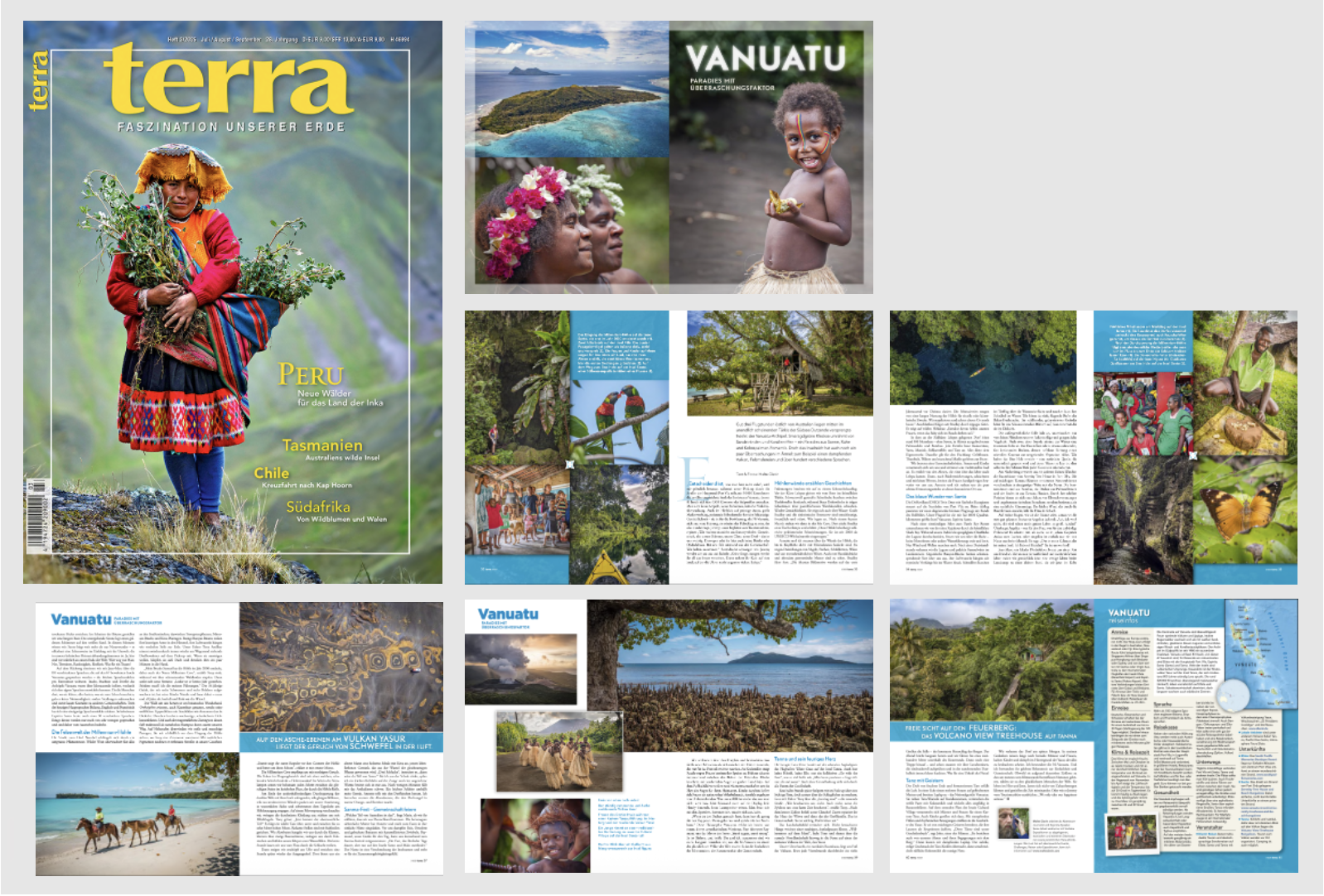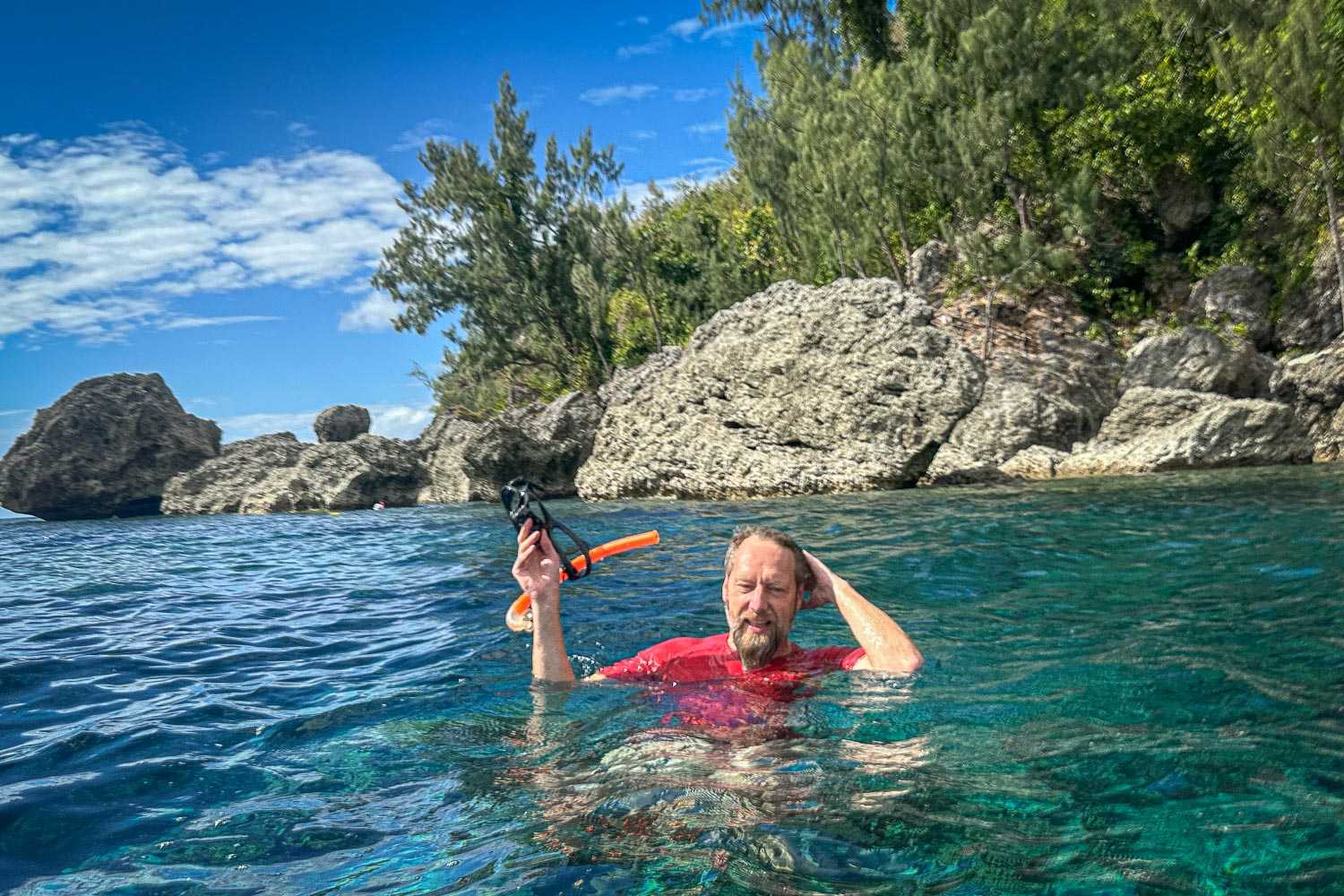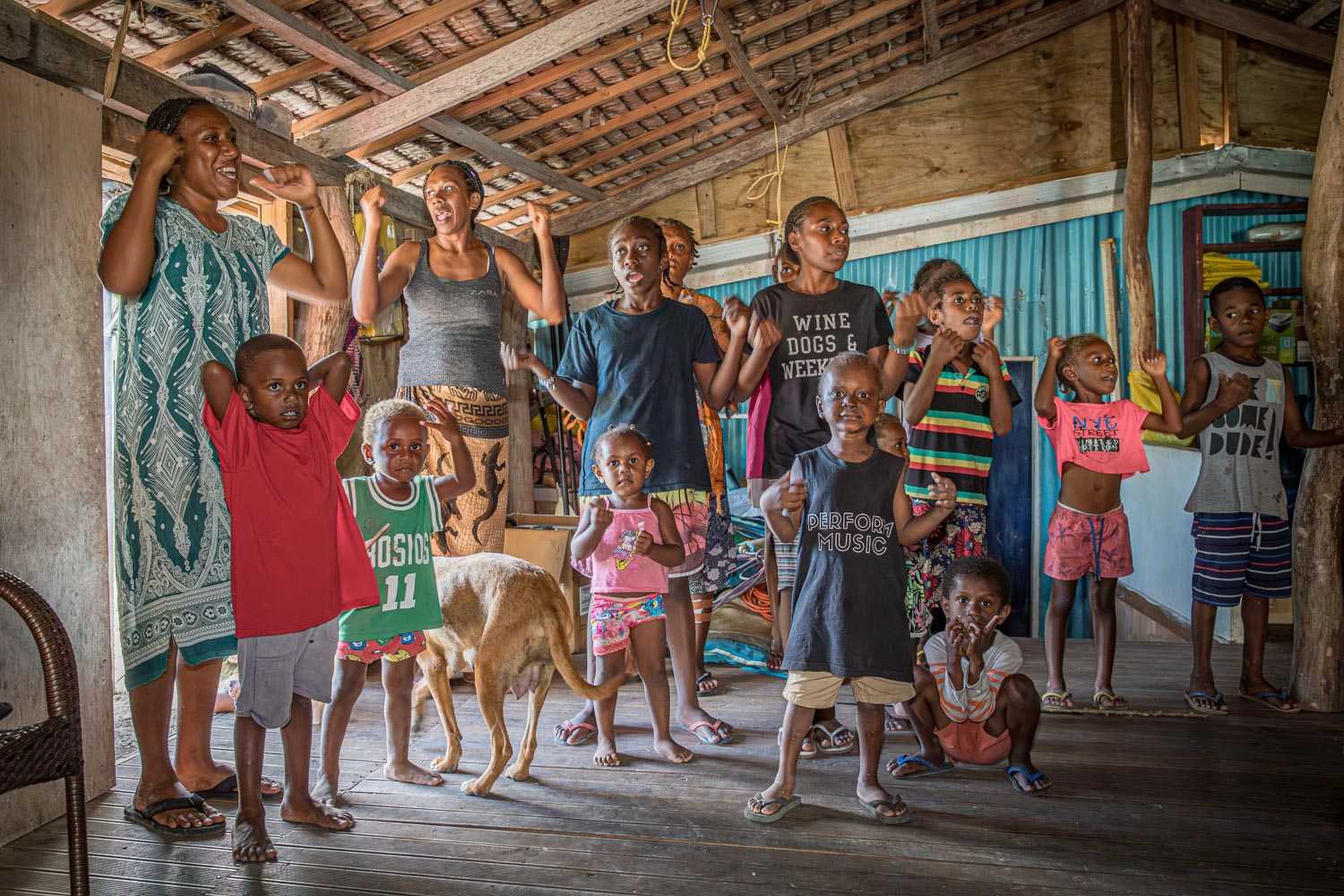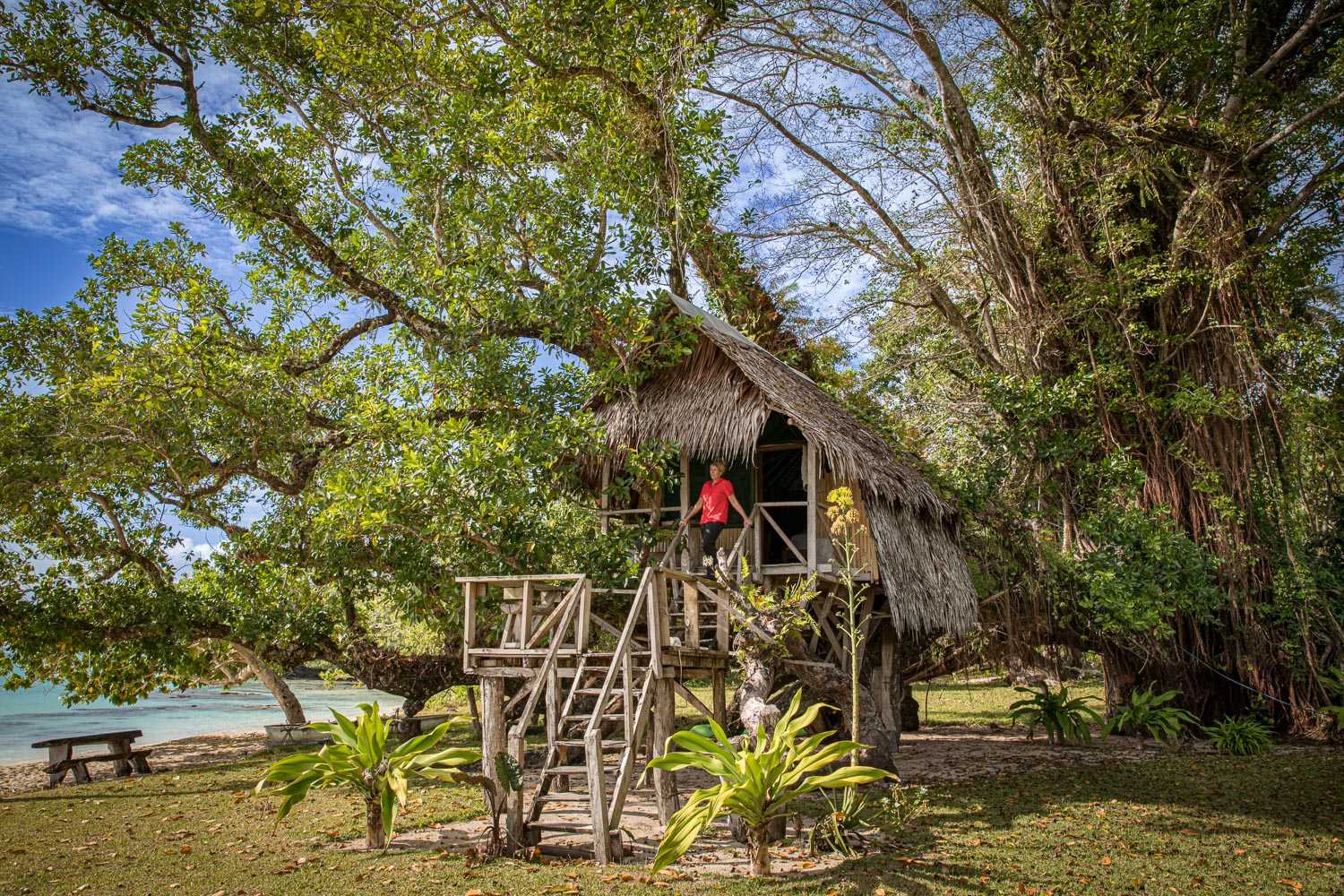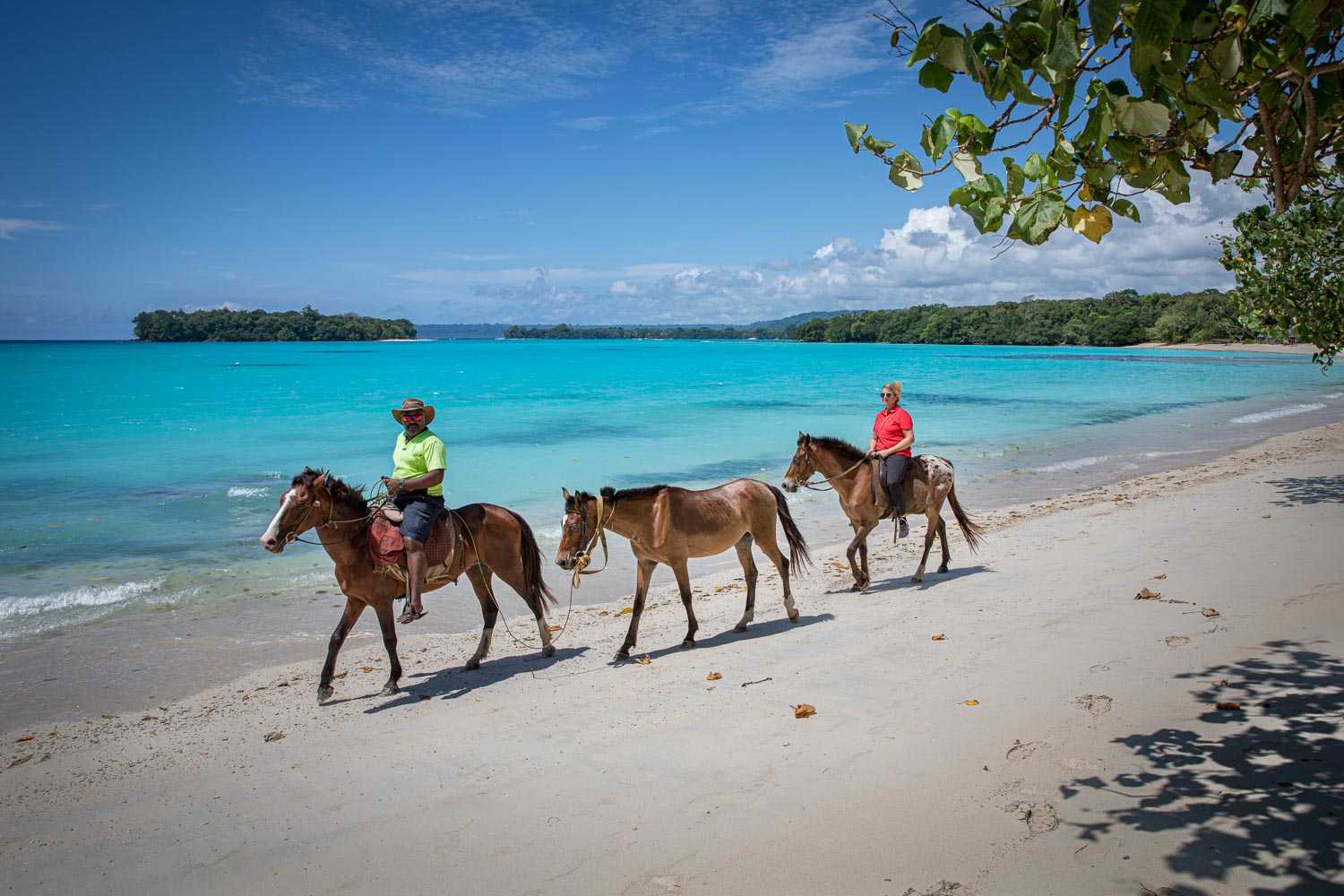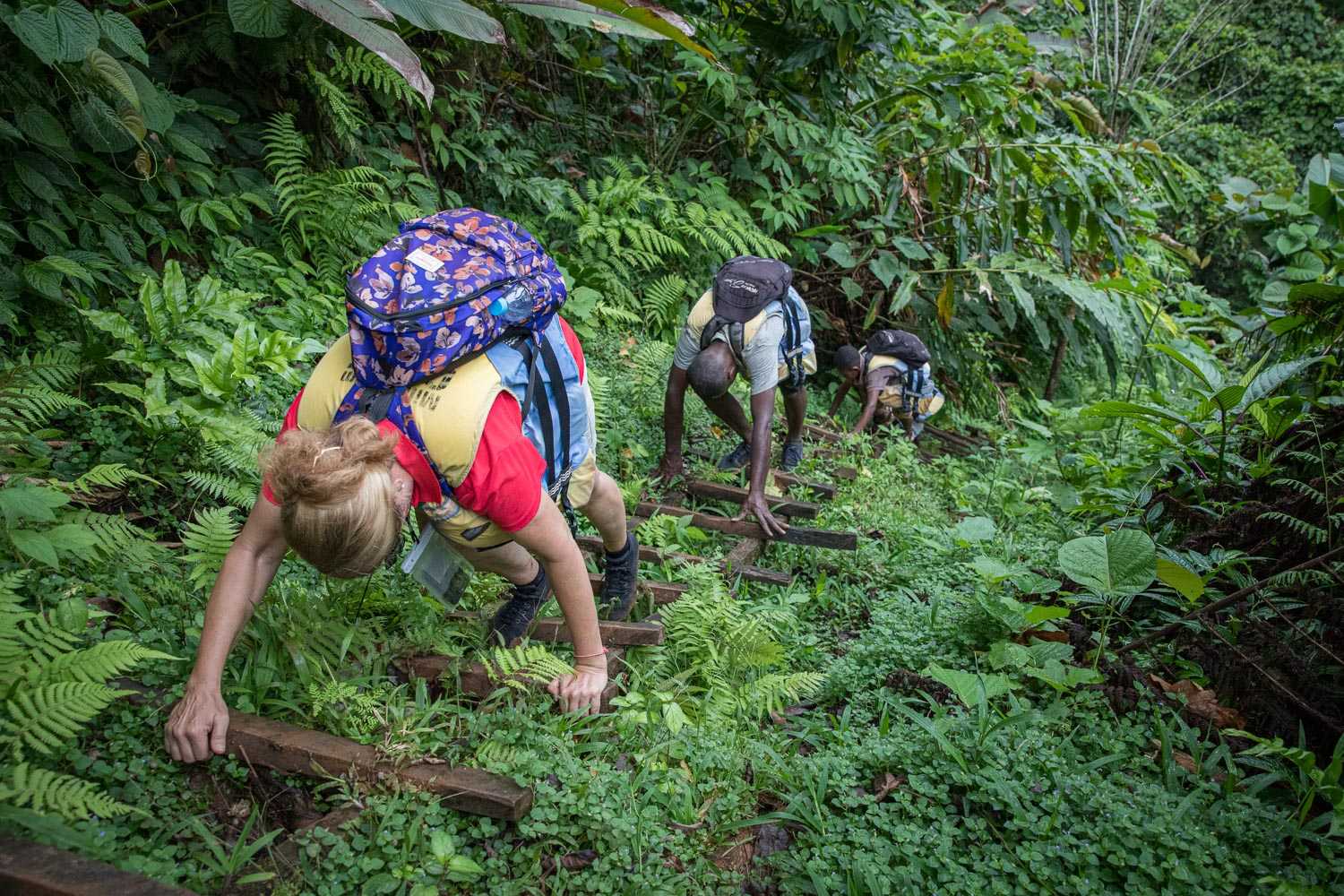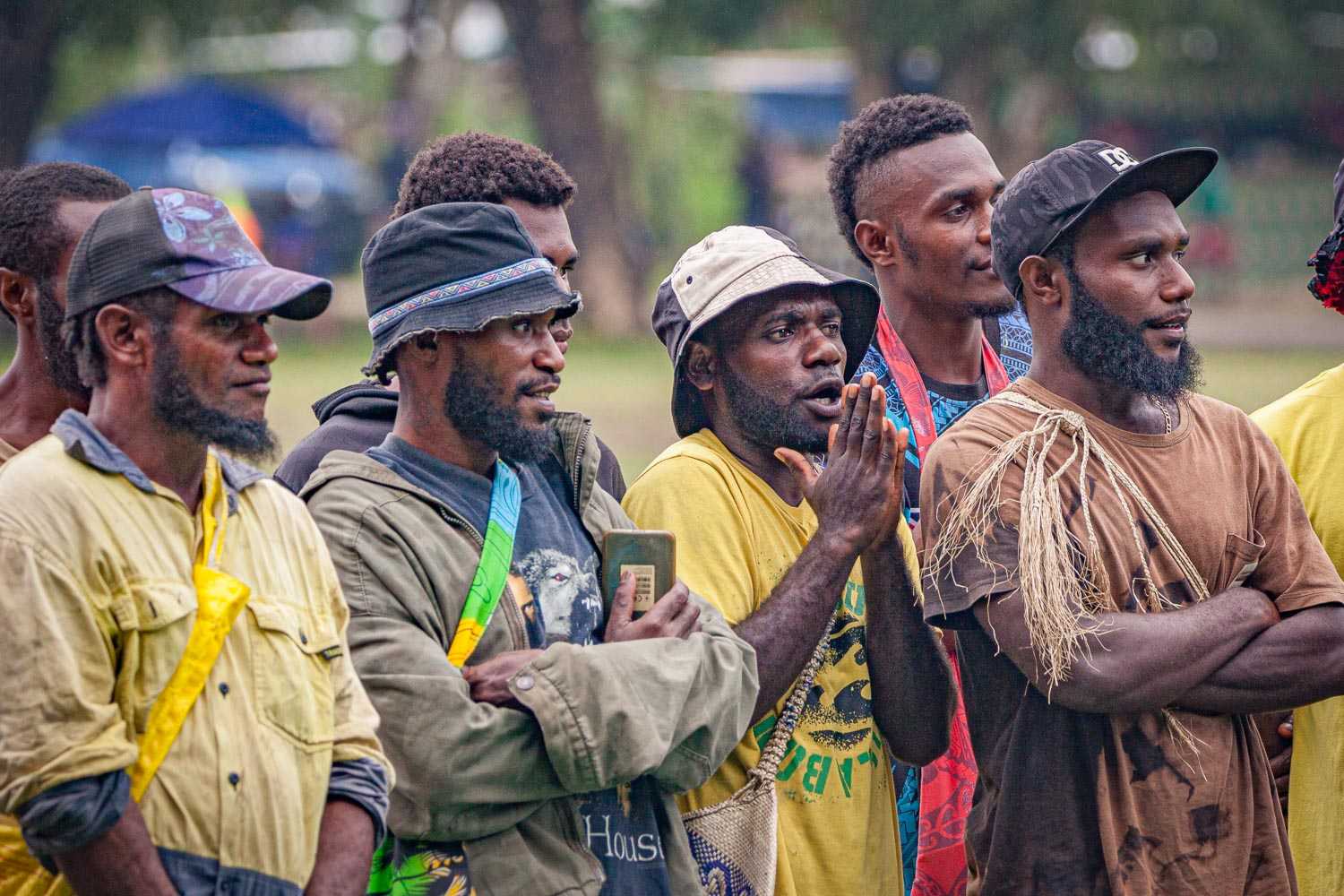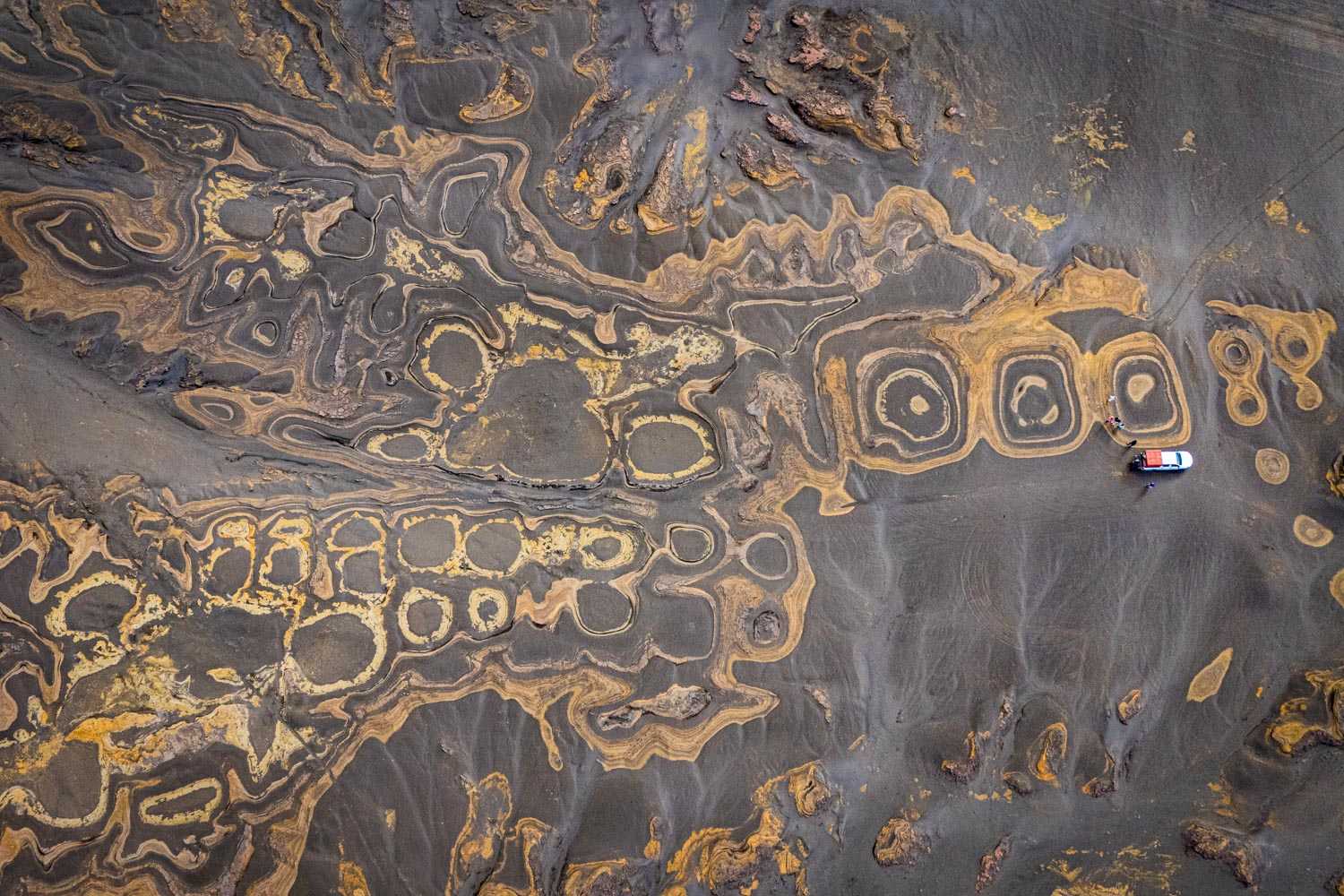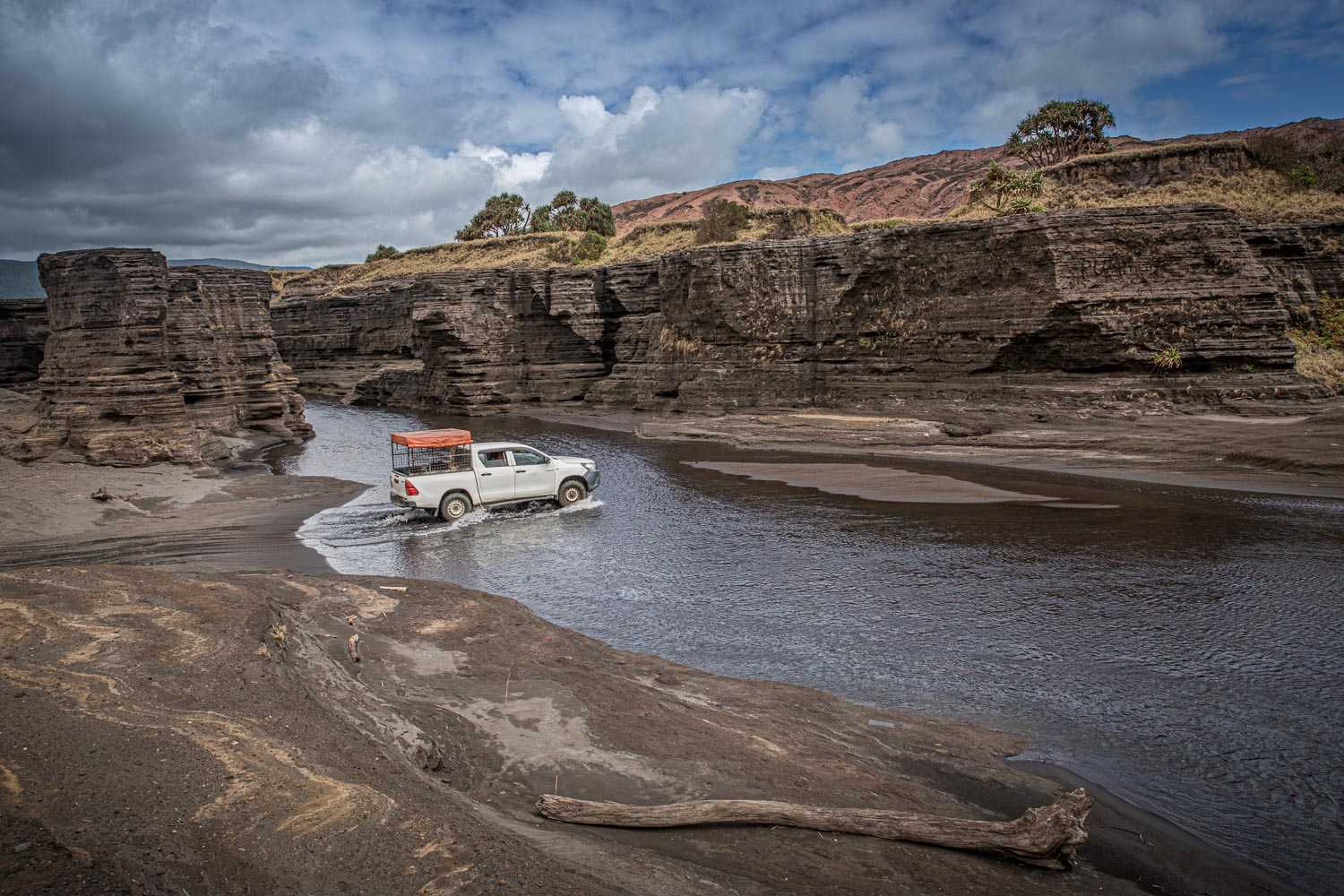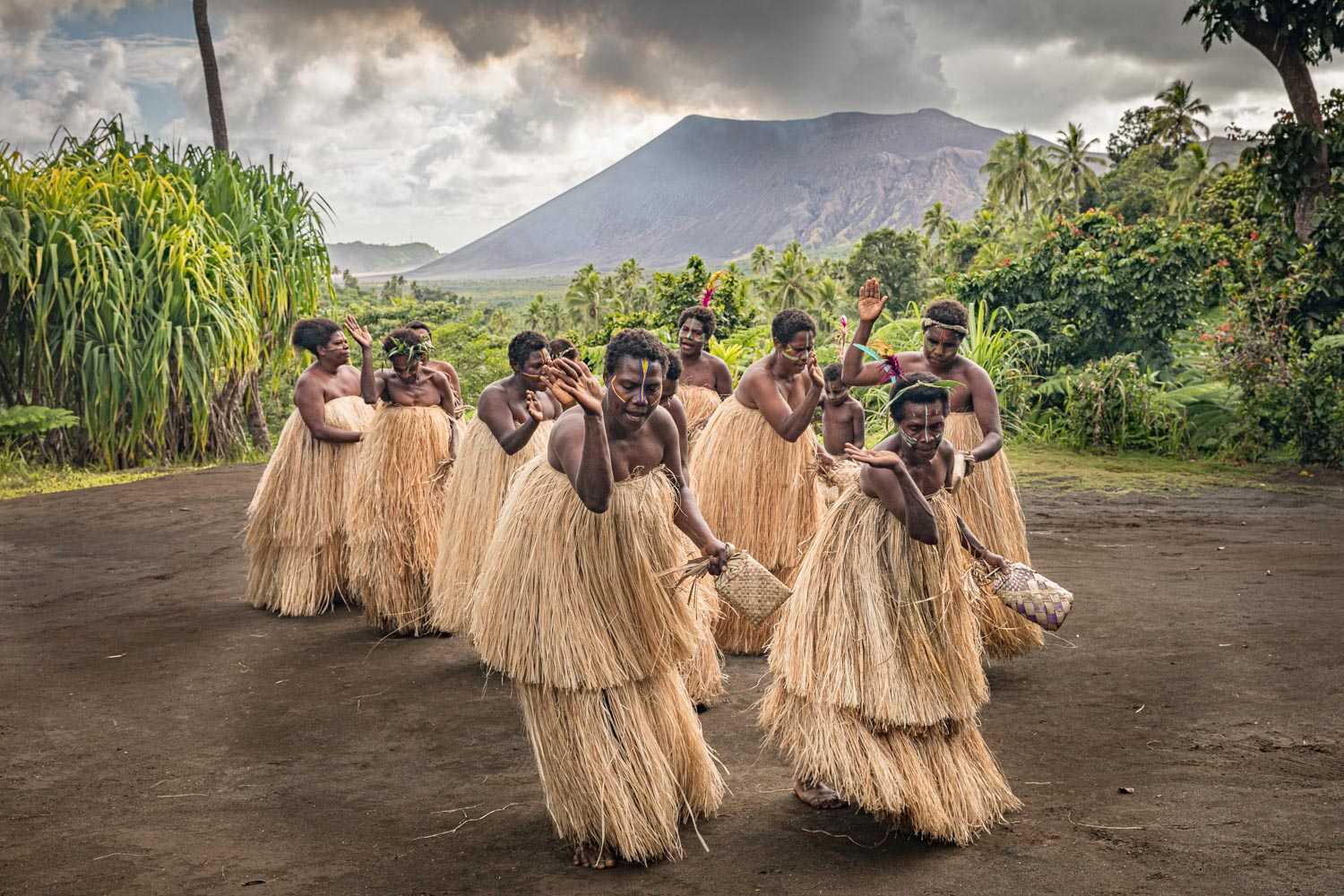Published in:

Germany’s biggest nature travel magazine
12 pages | text & photography
“We don’t care about status symbols”
The waters off the islands Lelepa and Moso are a multi-coloured snorkelling paradise.
Where cave walls whisper
Early in the morning, we set off on a snorkelling trip. Off the coast of Lelepa, we glide from the boat into the crystal-clear turquoise water. Black and white striped butterflyfish dart between table corals, while blue surgeonfish hover in lazy shoals above pastel-coloured soft corals. Again leisureliness. It is also evident above the water: guide Bradley and the local boat crew are relaxed, friendly and easy-going. We dock. After a short walk, we arrive at the Fels Cave. Bradley pulls out his torch and explains: “This cave is home to numerous prehistoric rock paintings. It has been a UNESCO World Heritage Site since 2008.”
“We still respect and honour this place today“
Annette and I marvel at the walls of the cave, which are densely covered with rock paintings up to head height. They show depictions of birds, fish, turtles, whales and human-like creatures. Red handprints and abstract geometric patterns can also be seen. Bradley continues: “The oldest motifs are dated to around the 1st millennium BC. The cave art here is evidence of a long history of use for ritual or artistic purposes. We still respect and honour this place today.”
Women and children on Moso sing us a song that tells us about their ancestors who once came across the sea and founded the first settlements here.
We then follow Bradley through lush greenery. He points to wild hibiscus: “Extracts from it help our women when the baby is turning in the belly.”
Women and children gather around us
We enter a communal hut. Women and children gather around us and sing a traditional song. It tells of the ancestors who once came across the sea and founded the first settlements on Lelepa. Then, after reassurances, shyly and with quiet words, the women spread out handmade souvenirs in front of us. Annette and I choose a few beautiful pieces that reflect this special place.
An autumn leaf (Doleschallia bisaltide) on the island of Nguna.
The blue wonder of Santo
The DeHavilland DHC6 Twin Otter with fifteen passengers heads for the runway at Port Vila. As we take off, we pass nine smaller aircraft lying idle on the edge of the tarmac. Our destination is the largest island in Vanuatu, covering almost 4,000 square kilometres: Espiritu Santo.
Kayak tour through the crystal-clear Shark Bay
Santu Island: On the way to the Blue Hole, a freshwater spring in the middle of a river.
After three quarters of an hour, we leave the lagoon and head further inland. Gigantic banyan trees spread their shady branches above us, their aerial roots hanging down into the water like mystical curtains. Swallows dart low over the surface of the water, dipping their beaks into the water as they approach. We hear the deep, plaintive call of a Vanuatu imperial pigeon. Its iridescent green-violet plumage flashes briefly between the leaves, then it disappears into the lush thicket.
Even at a depth of five metres, every pebble is visible
The extraordinary silence continues, accompanied only by the gentle splashing of our paddle strokes and the occasional bird call. After another hour or so, the water takes on a more intense colour. The river opens up into a sweeping, almost circular pool, its deep blue colour forming an almost electric contrast to the surrounding vegetation. We have reached the Blue Hole – a natural spring that is fed underground and whose water is so clear that even at a depth of five metres, every pebble is visible.
Santu Island: crystal-clear spring water at the Blue Hole.
In the afternoon, another small wonder awaits us – the tree houses of the Serenity Tree House in Port Olry. The structures built on mighty tamanu trees are masterpieces of the fusion of dwelling and nature. The window frames are made of bamboo, the roofs are a mosaic of palm leaves and the wood of the massive tamanu trees is used for the floor planks.
The elevated position offers protection from flooding and uninvited animal visitors
The elevated position not only offers protection from flooding and uninvited animal visitors, but also provides natural air conditioning. The light wind that blows through the treetops keeps the sometimes stifling heat at bay.
One of the Serenity tree houses in Port Olry, Santu Island.
When I ask how old the trees are, the always cheerful owner Angelica replies with a laugh: “Oh, I don’t know, they’ve been this big all my life, hahaha!”. Angelica in general. What a woman, what an irrepressibly cheerful character. It seems to me that she’s always looking for a reason to laugh in every conversation. But Angelica is simply a naturally cheerful person without any reason! She says: “This is my home, this is my island. I love it. Hahaha!” She’s amazing.
We take a break in the shade of the trees
Riding excursion with horse guide Jean-Marc on the beach at Port Olry.
The setting sun bathes the white sand in a golden light. At this moment, we realise that Santo holds far more than just natural wonders – it reveals a way of life in harmony with the environment that has been lost in our hectic home world. Yes, here we are truly at the end of the world. Far away from haste, hardship, deadlines, restlessness and vanity. Here it is: one of the zero points of the world. What a dream.
Vanuatu has the highest language density per inhabitant in the world
On the way back to the boat, we ponder with Jean-Marc about the 110 different languages spoken on the 67 inhabited islands of Vanuatu – the highest language density per inhabitant in the world. Islands, bays and villages in the Vanuatu archipelago have been isolated for thousands of years, allowing their own languages to develop. As the people there had everything they needed to live, there were hardly any points of contact with other communities. Despite today’s main languages being Bislama, English and French, a unique linguistic diversity has been preserved. Espiritu Santo is still home to around 30 different languages. Some of these are only spoken by very few people and are therefore threatened with extinction.
View of the east coast of Santu Island, south of Port Olry.
The hidden rock world of the Millennium Cave
The road to the village of Nambel winds its way through a sea of lush green vegetation. Wild vines overgrow almost all the plants along the roadsides, interspersed with angel’s trumpets, mimosa bushes and kava plantations. Huge banyan trees stretch their gnarled arms into the sky, their aerial roots hanging to the ground like twisted ropes. From time to time, our driver Tony Andikar picks up villagers from the roadside on the pick-up. When they want to get out, they tap on the roof and press a few coins into his hand.
“My brother Samuel discovered the cave in 2000“
“My brother Samuel discovered the cave in 2000, hence the name,” says Tony proudly as we trudge across the smacking forest floor. Then his voice lowers: “Unfortunately, he died last year. I’ve been doing most of the tours since then.” The 34-year-old guide, who grew up with six sisters and six brothers, has his children Natalie and Isaac with him – nine and eleven years old, barefoot and as agile as mountain chamois.
Santu Island: On the way to the Millennium Cave, slippery and steep key sections are secured by wooden steps.
The forest around us is a botanical wonderland. Orthosiphon aristatus, also known as cat’s whiskers, stretches its whitish labiate flowers with stamens like antennae through the thicket. Waxy, scarlet-coloured heliconia flowers glow next to it. The magenta-coloured ornamental ginger, whose sap is traditionally used as a natural shampoo, also lines our path. We overcome steep and muddy passages on wooden steps.
Tony performs a ceremony in front of the entrance to the cave
Tony performs a ceremony in front of the entrance to the cave: Using natural pigments, he draws dark reddish-brown stripes on our faces. “This shows respect for the spirits of the cave and asks for their protection,” he explains with a serious expression.
Santu Island: Our guide Tony performs a simple face-painting ceremony in front of the entrance to the Millennium Cave. This expresses respect for the spirits of the cave and asks for their protection.
The Millennium Cave welcomes us with a musty odour. The rocks in the entrance area are covered in a soft, smelly layer – bat droppings! In the light of our headlamps, we carefully place each step between the slippery stones in the knee-high river that meanders through the cave.
“Now comes the adventurous part!“
At the end of the 90-minute traverse of the marvel of towering walls, some of which are smoothly polished and others have a rough texture, we pack our photo equipment into waterproof bags. Then we swim towards the daylight at the cave exit. We catch our breath on a rocky outcrop, wring out soaked clothes and fortify ourselves with cake and muesli bars. Tony grins: “Now comes the adventurous part!”
Santu Island: All alone, the five of us brace ourselves in the Millennium Cave. We are amazed by the rock structures and the cave ceiling, which is up to 50 metres high.
What follows is a wild dance over, under and between rock monsters up to ten metres high. Some tricky sections are secured with steel cables. We shimmy through the gorge like acrobats, climb over huge tree trunks, squeeze through rock niches and cool our bodies under waterfalls. For the last hour, we let the river carry us through the gorge.
A slight tingling sensation on my tongue and a pleasant warmth spread through me
Then, exhausted, we climb down to the shore and reach the village we came from an hour later. There, an elderly man hands us a wooden bowl of kava, the clay-coloured drink made from the root of the plant of the same name. “Three sips,” he instructs, “then you become part of Santo.” I take a large glass. A slight tingling sensation on my tongue and a pleasant warmth spread through me. After a few minutes, I find it difficult to articulate. A light haze envelops my mind. Annette is romping around with the village children. I silently watch the evening sun – it bathes the jungle in liquid gold.
Santu Island: After crossing the Millennium Cave, an adventurous climb through niches, over tree trunks, in the water and along large rock monsters follows.
Sanma Festival – Celebrating community
“Which part of Australia is this?” asks Marie when we explain that we’re from Germany. The warmly smiling mother-of-seven has invited Annette and me to eat in her simple hut. Rice, omelettes and baked bananas with caramelised onions are steaming in front of us.
“A festival that lasts fifteen days“
Raymond, our guide for the day, had taken us to the Sanma Festival without further ado: “A festival that lasts fifteen days but only takes place on the islands of Santo and Malo.” The name is a fusion of the island names and thus symbolises a feeling of togetherness.
Marie, who invites you to lunch at the Tyrannus Mission Centre (Santu Island) during the Sanma celebrations.
What strikes us again is what you can’t see
On the football pitch, two men’s teams compete for the honour of their hometown. Right next to them, women are engaged in an intense volleyball match, also cheered on by bystanders.
What strikes us again is what you can’t see: Nobody is staring at displays, no mobile phones are ringing, no loudspeakers are blaring. People are happy with the athletes, commenting, chatting, laughing!
Visitors to the Sanma celebrations in a village outside Luganville, Santu Island.
“If you’ve done three things, then you’ve done enough for the day. Then go out and talk to the neighbours.” I learnt this philosophy of Vanuatu from an older American missionary. Now Raymond translates the motto of the festival Yumi tugeta, yumi strong. It is Bislama and means, you guessed it: You and I, together we are strong. We are beginning to understand what makes the Ni-Vanuatu one of the happiest peoples in the world: it is the simplicity of togetherness, the cohesion of the community.
“Go with the flow“
Tanna and his fiery heart
The aged Twin Otter lands on the narrow tarmac runway at White Grass Airport, Tanna Island. Here, too, there is no rush, no hurry, just a collective “go with the flow”, which means anything can happen. The only question is if and when.
The ash plains around the Yasur volcano on the island of Tanna in Vanuatu are surreal, windy and with sulphur in the air.
This basic attitude also runs through every fibre of society. Half an hour later, we are sitting in the pick-up. As we bump over a potholed track, driver Tony is not complaining about any of the potholes, but is happy about the dancing road.
“That’s community. It’s important. That’s what we live for.“
“We don’t complain. Not even when the cyclones give us a hard time,” says Tony. “After the last cyclone, our clan chief ordered us repair the widow’s house first. And then the extended family. That’s community. It’s important. That’s what we live for.”
On the way to the Yazur volcano, the Imayo river has to be crossed in the middle of the ash plain.
The landscape changes. Densely overgrown slopes give way to a dark grey dusty plain. “Welcome to Mars!” laughs Tony, pointing across a surreal lunar landscape to one of the world’s most active volcanoes, Yasur.
What a primal force of nature!
Our accommodation, a rustic tree house, lies at the foot of the volcano. Every quarter of an hour, a deep rumble breaks the silence – the constant heartbeat of the mountain. Evening slowly falls and we drive to about two hundred metres below the crater rim. Then up another flight of steps – and we are amazed by the lava fountains that spray up impressively and shine ever more clearly in the increasing darkness. What a primal force of nature!
Annette walks across the ash plain at the Yasur volcano, Tanna Island.
Dance with ghosts
The smell of damp earth and fermented taro fills the square. In one corner, several women sit on woven mats and prepare laplap – Vanuatu’s national dish. They rub taro roots on coral stones, mix the white paste with coconut milk and wrap everything carefully in banana leaves.
“These dances are our history book“
Men and women gather in the central square of Imaio village for a kastom dance. Children also join in. With stamping feet and rhythmic movements, they tell the story of Yasur. It is said to be inhabited by powerful spirits who express their moods as eruptions.
“These dances are our history book,” says John, one of the men. “The movements and the rhythm also tell us about our ancestors and their encounters with the mountain.”
Women from the village of Imaio during a Kastom dance performance, with the smoking Yazur volcano in the background.
Then we savour steaming laplap. The subtle, earthy flavour of the taro tubers is surprising, then sweet coconut milk caresses the nutty note.
We leave Imaio Village in the late morning. In my mind, painted men and women dance for a long time, children laugh and the Yasur steams, seemingly watching everything from a distance.
„We only take our happiness serious“
I admire the Ni-Vanuatu, their living commitment to simplicity. Although they are among the nations most affected by climate change due to disastrous cyclones, they are among the happiest people in the world. They live in the here and now, are not paralysed by worries about tomorrow and enjoy their time together. Or as Jeremy from the tourism office explained: “We only take our happiness serious”.
Read now:
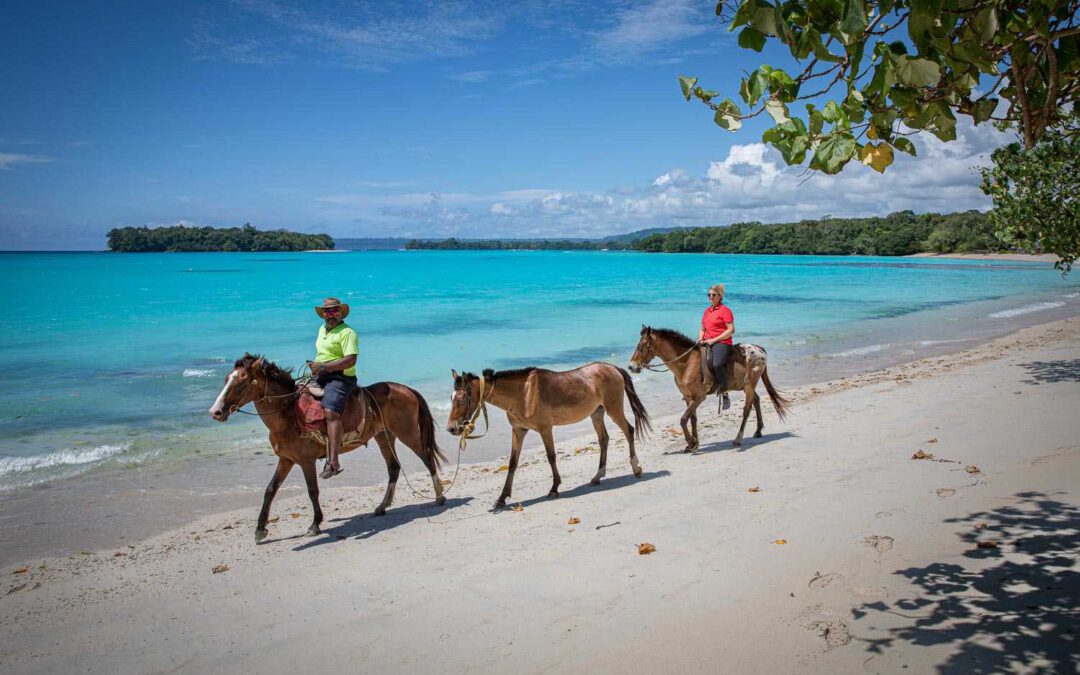
South Sea paradise with volcanic spectacle
Photo gallery Vanuatu
2 Min.Blue springs in the jungle, lava fountains against the evening sky – this visual journey through Vanuatu reveals a paradise without hustle and bustle, without traffic lights – but with plenty of nature and encounters.
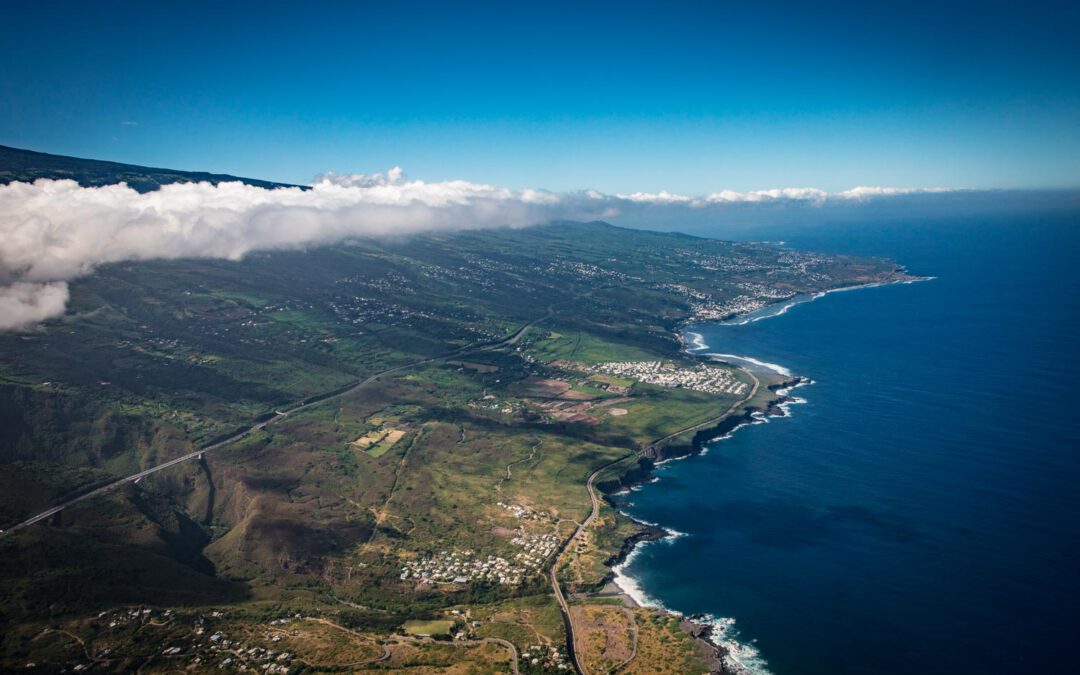
An island like no other
La Reunion – Like a trip around the world in five days
26 Min.Where else in the world can you splash in the sea in the morning, walk in the rainforest at noon, and marvel at a desert with an active volcano in the afternoon? Reunion offers the most diverse variety of landscapes, vegetation and cultures that I know.

A Piece of France in the South Seas
New Caledonia – South Sea with sunken forest and mangrove heart
19 Min.Like a South Seas dream come true, New Caledonia lies east of Australia in the Pacific Ocean. Seen from Europe, this is actually directly at the other end of the world. Those who take the long journey will experience turquoise water and dazzling white beaches as well as many surprises.

